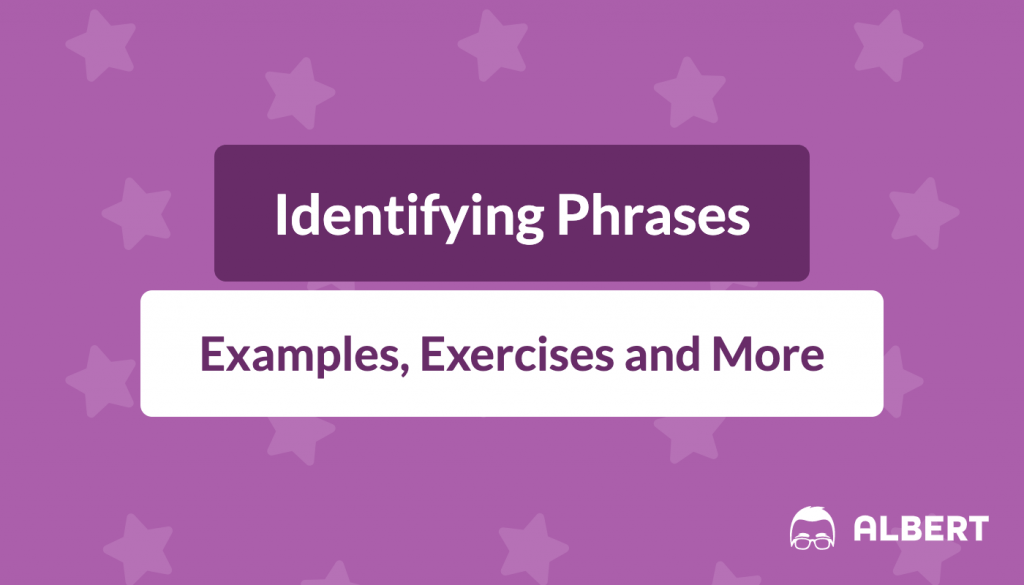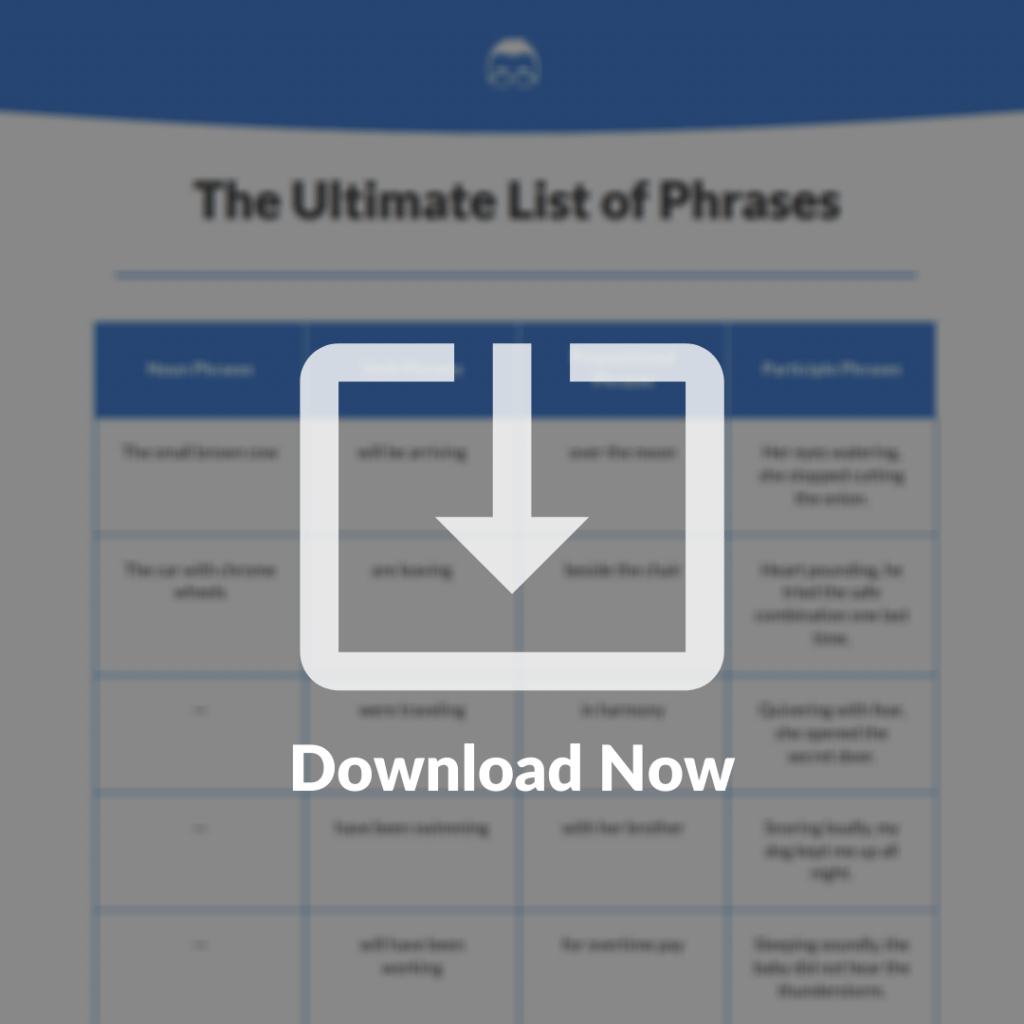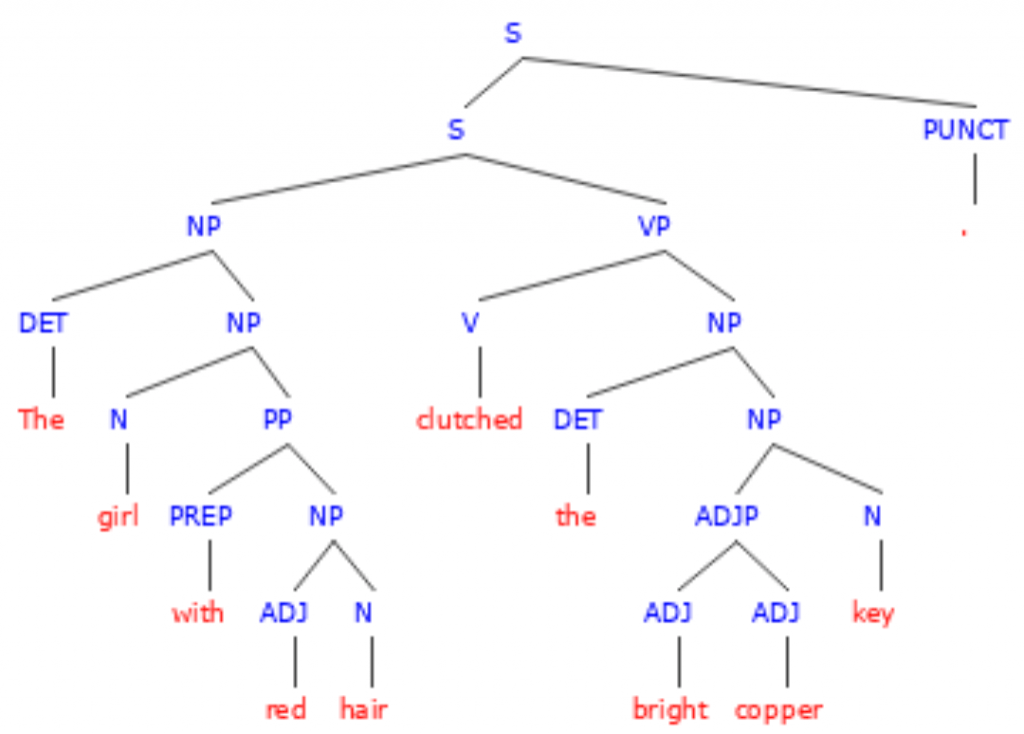When building simple sentences, writers know to use a subject and a verb to create a clause. Independent clauses contain a subject and a verb and create a complete thought, while dependent clauses contain a subject and a verb without creating a complete thought.
Like clauses, phrases are also a combination of two or more words in a sentence; however, unlike clauses, phrases do not contain both a subject and a verb.
There are many types of phrases, but they can be divided into three main categories: noun phrases, verb phrases, and modifying phrases. In this post, we will practice identifying these three categories of phrases and using each of them correctly in sentences.
When you’re ready, test yourself with a quiz and practice with our high-quality, standards-aligned questions here.
What We Review
The Basics of Identifying Phrases
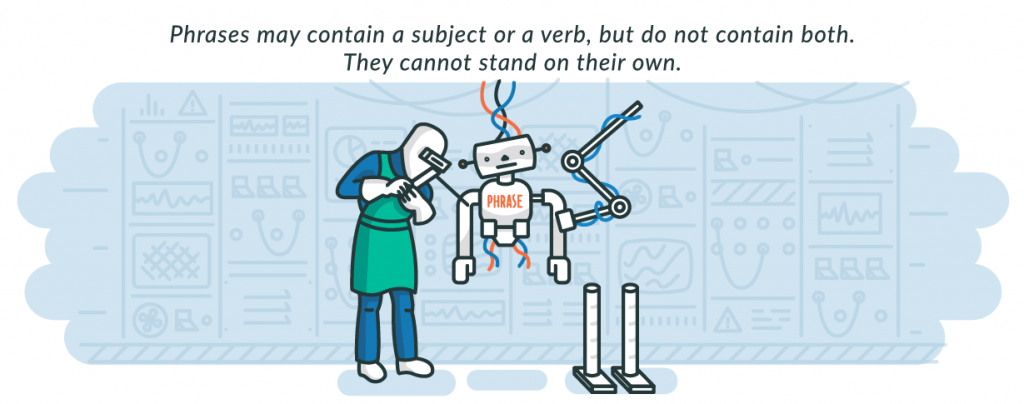
What are Phrases?
Phrases are a combination of two or more words that can take the role of a noun, a verb, or a modifier in a sentence.
Phrases are different from clauses because while dependent and independent clauses both contain a subject and a verb, phrases do not.
For example:
- The bright red ball bounced directly into a muddy puddle.
In the example above, there are two noun phrases. Each noun phrase above consists of a noun, an article, and one or two adjectives that modify the noun. Neither of these phrases contain a verb, so they cannot be considered clauses.
Here is an example of a clause below:
- The bright red ball that slipped from my hands bounced directly into a muddy puddle.
Do you see how the underlined clause in the above sentence contains both a noun or pronoun, that, and a verb, slipped? This dependent clause modifies which red ball landed in the puddle and is not considered a noun phrase.
What are the different types of phrases?
Phrases can be divided into three main categories: noun phrases, verb phrases, and modifying phrases.
Noun Phrases
Noun phrases consist of a noun and all of its modifiers. Modifiers can include adjectives, articles, participles, or possessive nouns and pronouns, just to name a few. Noun phrases can function as any noun in the sentence, whether as subjects, objects, or subject complements.
Noun phrases can be short or long depending on how much detail the writer wishes to include about a certain person, place, thing, or idea. Don’t let length fool you into thinking these are clauses!
For example:
- The setting sun glowing with colors of red, purple, and orange fascinated us this evening.
Can you believe that the underlined phrase above is all one noun phrase? Let’s take it apart:
- The setting sun includes an article, an adjective, and the main noun of the phrase.
- Glowing is a participle, or a verb acting like an adjective.
- With colors and of red, purple, and orange are both prepositional phrases that modify the noun.

Sometimes, noun phrases can appear as appositive phrases, a phrase placed after a noun to provide additional information.
Here is another example of a much shorter appositive noun phrase:
- Julie, my older sister, came to visit me the other day.
In the sentence above, both “Julie” and “my older sister” are nouns that could equally stand as the subject of the sentence. However, “Julie” is the subject of the sentence, while “my older sister” functions as an appositive phrase to make sure that her readers know who “Julie” is.
Additionally, when appositive phrases are separated from the rest of the sentence by a pair of commas, this means that they are non-essential to understanding the sentence. This means that if you take away the appositive phrase, the sentence will still make sense.
Other times, words that are typically categorized as verbs become nouns when they are used in a gerund phrase. Gerund phrases include a verb ending in -ing, an object, and modifiers.
For example:
- Walking on the beach is one of my favorite activities.
In this sentence, even though walking is usually categorized as a verb, in this sentence, it is being used as a gerund phrase, and it is the subject of the sentence.

Verb Phrases
Verb phrases consist of the main verb and its auxiliaries, or helping verbs. Unlike adjectives and noun phrases, adverbs that modify the verb are not considered part of the verb phrase.
For example:
- The turtle was running quite quickly considering the nature of his species.
In the sentence above, the verb phrase consists of only the main verb (running) and any helping verbs or auxiliaries (was).
Modifying Phrases
There are many types of phrases that all act as different types of modifiers. Most of these phrases modify single words in sentences; however, one type of phrase modifies the entire sentence!
Here are the different types of modifying or describing phrases:
1. Prepositional Phrases
Prepositional phrases consist of a preposition, its object, and any articles or modifiers. As a unit, prepositional phrases can be used to modify nouns or verbs by acting like adjectives or adverbs respectively.
For example:
Bambi frolicked in the meadow with Thumper.
The prepositional phrase in the sentence above is acting like an adverb by modifying the verb and answering where Bambi and Thumper frolicked.
Here is another example:
- The princess with long golden hair was trapped in a tower by a dragon.
In the sentence above, the prepositional phrase with long golden hair modifies the noun, princess, by describing her outward appearance.
2. Participle Phrases
Participle Phrases consist of a present or past participle (a verb ending in -ing or -ed), an object, and any modifiers. These phrases act like adjectives and always modify nouns. It is very easy to confuse gerund phrases with participle phrases because they look exactly the same! However, it’s important to remember that while participle phrases modify nouns, gerund phrases can actually replace nouns altogether!
For example:
- Present Participle Phrase: Gasping for breath, the dachshund barely made it home from his ten foot walk.
In the sentence above, the participle phrase gasping for breath describes how the dog felt after his “long” walk.
- Past Participle Phrase: Perched menacingly on the porch railing, the cat watched the neighbor’s dog.
In the sentence above, the participle phrase perched menacingly on the porch railing describes the body language and intentions of the cat.
3. Infinitive Phrases
Infinitive phrases are made up of an infinitive (the “to” form of a verb), an object, and any modifiers. Infinitive phrases can function as adjectives, adverbs, or nouns.
For example:
- Adjective Infinitive Phrase: My favorite movie to watch is Little Women.
In this example, the infinitive phrase to watch modifies the noun, movie and functions as an adjective.
- Adverb Infinitive Phrase: He studied all night to avoid failing his math test the next day.
In this sentence, the infinitive phrase, to avoid failing his math test the next day modifies the verb studied by telling us why he studied.
- Noun Infinitive Phrase: They wanted to visit New Orleans during Jazz Fest.
In this sentence, the infinitive phrase to visit New Orleans during Jazz Fest acts as a noun because it answers what “they wanted”.
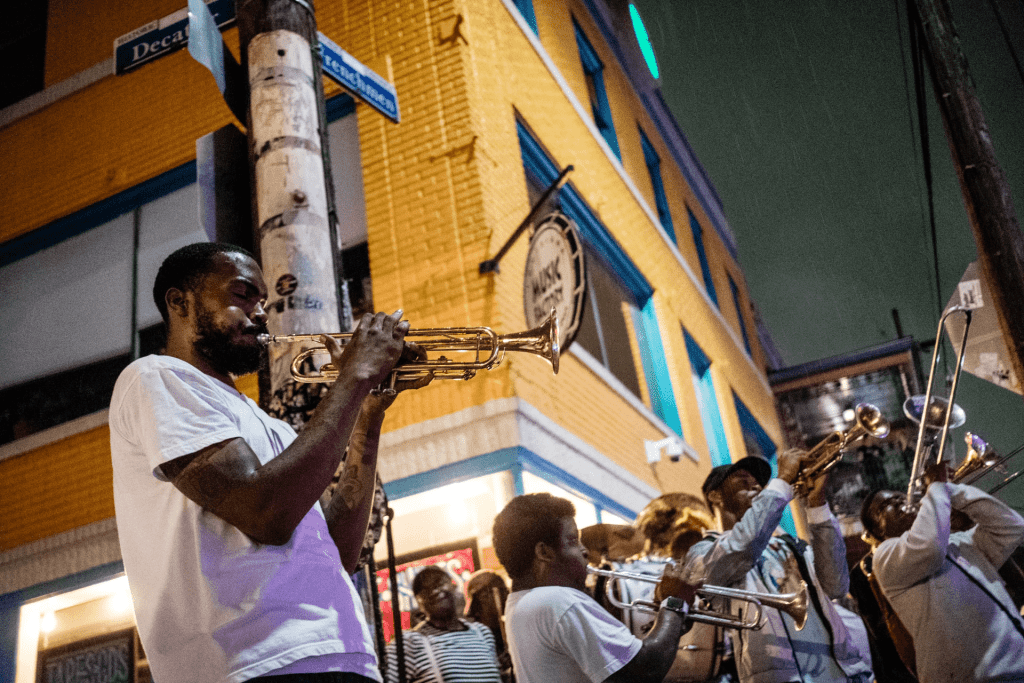
4. Absolute Phrases
Absolute phrases contain a noun, a participle, and any modifiers and/or objects.
These phrases are tricky for several reasons:
First, they look deceptively similar to independent clauses since they do technically contain a noun and a form of a verb. However, when you try to make an absolute phrase stand on its own, it does not make sense.
Secondly, absolute phrases are tricky because we could mistake them for dependent clauses. They are not dependent clauses because they do not meet the structural requirements of dependent clauses. Dependent clauses must start with either a subordinating conjunction, a relative pronoun, or an interrogative pronoun or expletive. If none of these are present, then it cannot be a dependent clause.
Thirdly, absolute phrases are sometimes hard to spot because they describe or modify an entire independent clause instead of a single word. This makes them different from participle, infinitive, and prepositional phrases.
Here is an example:
- Holding onto the rigging for dear life, I barely survived the storm that we encountered at sea.
In the example above, the absolute phrase modifies the entire independent clause by explaining how “I barely survived the storm”.
Return to the Table of Contents
3 Tips for Understanding Phrases
Here are some important tips to help you understand Phrases:

Tip #1. Phrases are not considered clauses because phrases do not contain both a subject and a main verb
For example:
- The dependent clause “Whenever I go to the beach” contains a subordinating conjunction, a subject, and a verb.
However, the phrase “to go to the beach soon” does not contain any of the above. Instead, it is made up of an infinitive phrase acting like a noun direct object, a prepositional phrase, and an adverb. To make this a clause, we would need to add a subject and verb.
Tip #2. Phrases can be used to replace nouns, verb, adjectives, and adverbs
For example:
- I love to trail run on the weekends.
In this sentence, the infinitive phrase acts like a noun and replaces the direct object of the verb, love.
Here is another example:
- I love to run in the woods to calm my mind.
In this sentence, the prepositional phrase replaces the adverb by describing where the speaker “loves to run”.
Tip #3. Phrases can be used to modify nouns, verbs, or entire sentences
For example:
- Palms sweaty, he passed the baton carefully to the next runner.
In the sentence above, the participle phrase modifies the subject, he by describing his physical state.
Here is another example:
- Her imagination running wildly, she rapidly turned the pages of the novel as quickly as she read them.
In the sentence above, the absolute phrase her imagination running wildly modifies the entire sentence by describing the overall experience of the reader and explaining why she turned the pages so quickly.
Return to the Table of Contents
Applying the Basics: Phrases Review & Practice
Now that you understand how phrases function in sentences, review the anchor chart below and complete the review to fully understand how to use and recognize phrases.
The Ultimate List of Phrases
Refer to the graphic below to learn the different types of Phrases:
This list, obviously, does not include all possible phrases; however, it is meant to be used as a guide while identifying different types of phrases.
Phrase Exercises and Review
Now that you know some common phrases, test your ability to find these in the sentences below.
Select the noun phrase(s) in the sentences below. Remember, noun phrases consist of the main noun, articles, and modifiers.
1. The girl with red hair clutched the bright copper key.
In this sentence, there are two noun phrases! The first noun phrase is the subject of the sentence: the girl with red hair. The second noun phrase is the direct object, the bright copper key.
2. The forest smelled like fir, goldenrod, and rich soil.
In this sentence, there are two noun phrases. The first noun phrase in this sentence is the subject, the forest. The second noun phrase is in the last prepositional phrase, fir, goldenrod, and rich soil.
Select the verb phrase(s) in the sentences below. Remember, verb phrases consist only of the main verb and a helping or auxiliary verb.
3. A ferocious-looking dog was barking repeatedly at us while we were walking yesterday.
In this sentence, there are two verb phrases. The first is was barking, and the second is were walking.
4. Your package will be shipped first thing in the morning.
In this sentence, the verb phrase is will be shipped.
Select the participle phrase(s) in the sentences below. Remember, particle phrases modify nouns by acting like adjectives.
5. Waving rapidly, the two red flags warned swimmers not to enter the water.
In this sentence, waving rapidly is the participle phrase that modifies the subject, the two red flags.
6. Students confused by the assignment were asked to stay after class for extra help.
In this sentence, confused by the assignment is the participle phrase that modifies the subject, students.
Pro tip: Remember, phrases are always made up of two or more words, but do not contain both a subject and a verb. Different types of phrases have different functions; for example, while one phrase may modify a word in a sentence, another phrase may replace that word altogether.
For additional practice, check out our Phrases practice content on Albert.
Return to the Table of Contents
Try for Yourself: Phrases Quiz

Feeling confident in your understanding of Phrases?
Take this short six-question quiz to see what you’ve learned:
1. Can a gerund phrase replace any noun in a sentence?
- Answer: Yes
- Correct Explanation: That’s right! Gerund phrases can replace any noun in a sentence, from subjects to objects to subject complements.
- Incorrect Explanation: Sorry, that’s not right! Remember, gerund phrases can replace any noun in a sentence, from subjects to objects to subject complements.
2. Do infinitive phrases modify or replace adjectives, adverbs, and nouns?
- Answer: Replace
- Correct Explanation: That’s right! Infinitive phrases replace adjectives, adverbs, and nouns instead of modifying them.
- Incorrect Explanation: Sorry, that’s not right! Remember, infinitive phrases replace adjectives, adverbs, and nouns instead of modify them. Participle and prepositional phrases are modifiers.
3. In this sentence, is the infinitive phrase, “to sleep” replacing a noun, adverb, or adjective?
I want to go to sleep before midnight tonight.
- Answer: Adverb
- Correct Explanation: That’s right! The infinitive phrase, to sleep answers where the speaker “wants to go”, and is therefore replacing an adverb in this sentence.
- Incorrect Explanation: Sorry, that’s not right! Remember, infinitive phrases that answer questions such as how, why, when, and where replace adverbs in sentences because they modify the verb.
4. In this sentence, is the underlined phrase a participle phrase or an absolute phrase?
Her fur a tangled mess, the poodle reluctantly agreed to a bath.
- Answer: Absolute
- Correct Explanation: That’s right! In this sentence, the phrase her fur a tangled mess is absolute because it modifies the entire independent clause instead of just one word. The absolute clause answers why the poodle agreed to a bath.
- Incorrect Explanation: Sorry, that’s not right! Remember, absolute phrases modify entire clauses while participle phrases only modify one noun.
5. In this sentence, is the underlined phrase a participle phrase or an absolute phrase?
Muscles flexed, he swiftly took down his opponent on the wrestling mat.
- Answer: Participle
- Correct Explanation: That’s right! In this sentence, the phrase muscles flexed is participial because it acts like an adjective by modifying the noun, he.
- Incorrect Explanation: Sorry, that’s not right! Remember, absolute phrases modify entire clauses while participle phrases only modify one noun.
6. In this sentence, what type of phrase is underlined?
We were going to ride our bikes this afternoon, but it started raining.
- Answer: Verb phrase
- Correct Explanation: That’s right! The underlined phrase, were going is a verb phrase that combines the main verb with an auxiliary or helping verb.
- Incorrect Explanation: Sorry, that’s not right! Remember, verb phrases consist of the main verb and any auxiliary or helping verbs.
For additional practice with phrases, check out our practice on Albert: Identifying Phrases.
Return to the Table of Contents
Teacher’s Corner for Phrases
For many students, phrases often come across as intimidating and even confusing. With so many varieties and functions of phrases, it is easy to understand our students’ hesitation to tackle this specific grammatical concept. When approaching teaching phrases for the first time, consult the Common Core English Language Progressive Skills Chart to first identity where you students stand in their grammatical understanding, but also how to best help your students reach a point where they can comfortably get to know phrases and even practice using them in their writing.
For specific standards on the different types of phrases, check out the Common Core State Standards website.
Albert’s Identifying Phrases Practice is a helpful tool for students who are still getting familiar with these different types of phrases. Once students have this down, they can move on to practicing with each type of phrase individually. When ready, teachers can assign pre-made assessments and quizzes to check students’ overall understanding.
Summary for Phrases
Phrases can be divided into three main categories: noun phrases, verb phrases, and modifiers.
Noun phrases are made up of a noun and all its modifiers. These phrases can replace any noun in a sentence.
Verb phrases are made up of the main verb and its auxiliaries. Unlike adjectives, adverbs that modify the verb are not considered part of a verb phrase.
There are many other types of phrases that act as different types of modifiers. Prepositional phrases, participle phrases, infinitive phrases, and absolute phrases are just a few!
Be sure to check out our grammar course for more phrase practice.
You can also access over 3,400 high-quality questions that address nearly every grammatical concept.
Need help preparing for your Grammar exam?
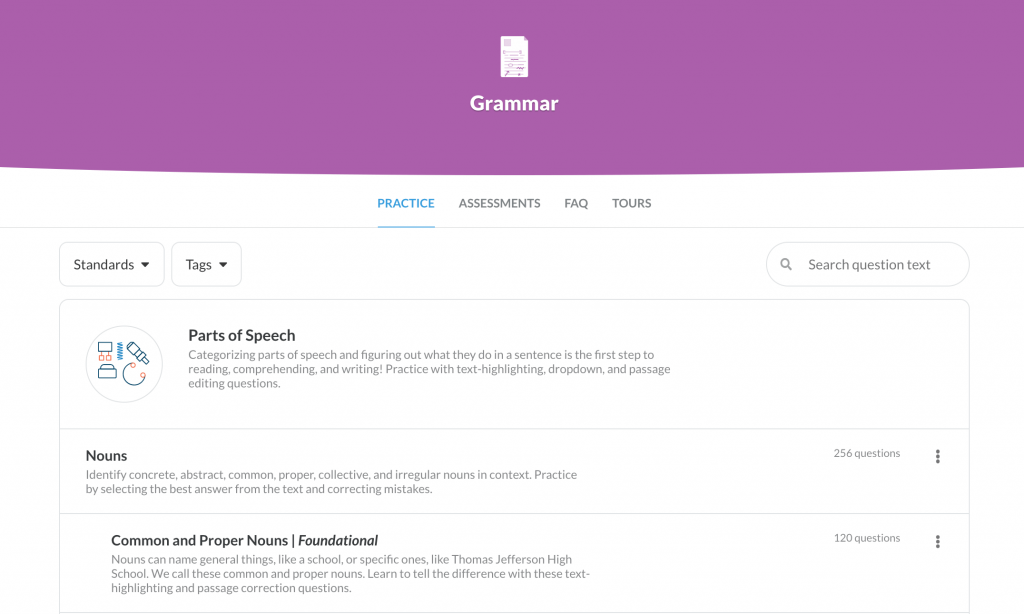
Albert has hundreds of grammar practice questions with detailed explanations to help you master concepts.

